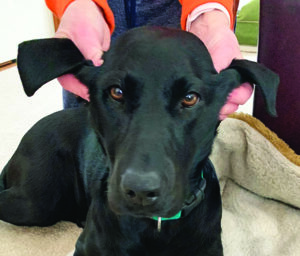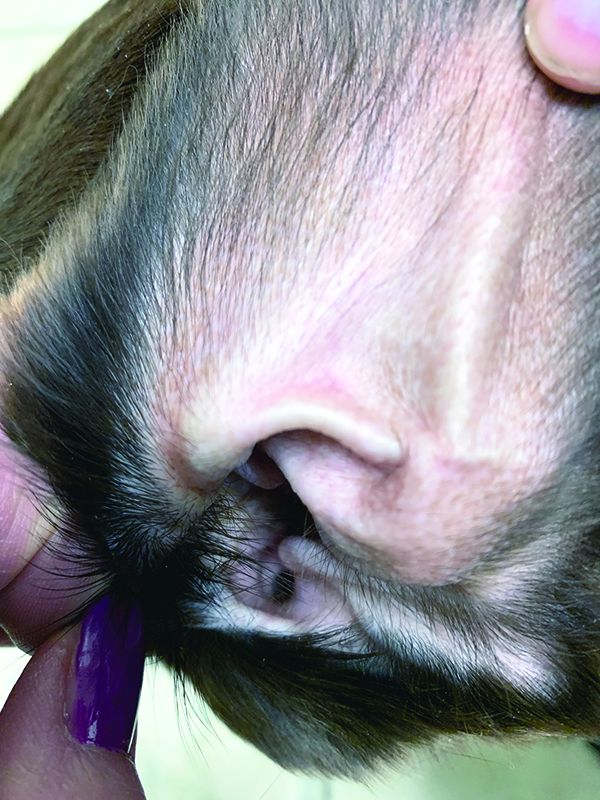As a small-animal veterinarian, I see dogs for “check ears” appointments daily. Ear problems are common in dogs – the basic anatomy of the canine ear and certain breed characteristics are predisposing factors for ear infections – but fortunately, much can be done to overcome these factors and prevent infections.
Ear monitoring and maintenance is important for preventing infections. Ear infections are obviously uncomfortable for your dog. But the problem can get more serious than that. Left untreated, infections cause worsening pain and damage in the ear, including open sores, ulcers, swelling, and bleeding. Over time, this can become so severe that the ear canal becomes completely closed off by scar tissue. The closed-off ear will still be painful and infected – and now virtually impossible to treat. The only recourse in this end-stage situation is surgical ablation (removal) of the entire ear canal.
Untreated ear infections can also result in neurological disorders including head tilt, loss of hearing, balance problems, and facial nerve paralysis. Dogs who shake their heads in pain are prone to aural hematoma, where blood vessels in the pinna (ear flap) rupture from the force of the head-shaking and the pinna fills with blood. This painful complication typically requires surgical intervention or placement of a drainage tube for several weeks.
PROBLEMATIC EAR ANATOMY
The anatomy of the dog’s ear canal makes it the perfect place for bacterial infections to brew. It’s a warm, dark, closed-off space with minimal air flow – like an incubator. Add in a little natural ear wax as a culture medium and you have the perfect environment for microorganisms to grow and multiply.
Breeds with long and/or heavy ears, such as Cocker Spaniels, Springer Spaniels, and Bassett Hounds, have ideal bacterial incubators. Some breeds have a tendency to grow hair from deep in their ear canals, decreasing fresh air flow. Poodles, Schnauzers, and Shih Tzus are great examples of this. It is important in these breeds that the ear hair be gently plucked or extracted to open up the ear canal. Trimming this hair doesn’t help as it leaves the deeper canal still full of hair.
Dogs who are bathed frequently or love to swim can end up with excess moisture in the ear canal. This makes the environment even more inviting to unwelcome microorganisms.
Allergies are a common ailment in dogs. The hallmark of allergies in dogs is normal, healthy looking skin that seems to itch and becomes inflamed. Well, guess what? The ear canals are lined with skin! And allergic inflammation cranks up the heat in the microbial incubator!
There are currently many safe and effective ways to manage allergies in dogs. If your dog suffers from chronic ear infections be sure to ask your veterinarian about the possibility of underlying allergies. You’re probably not going to stop your dog’s recurrent ear infections until his allergies are controlled.
FREQUENT EAR EXAMS
The best way to ensure that your dog enjoys the benefits of clean, comfortable, healthy ears is to be observant and involved. Never ignore the ears.

If you are one of the lucky ones whose dog’s ear canals are always quiet, clean, comfortable, and odor-free, it may not be necessary to flush or cleanse them regularly. For dogs who have recurrent ear infections, I recommend preventative cleansing once a week, for the life of the dog. More often than that, unless directed by your veterinarian, can be irritating to the ear canal.
Cleaning your dog’s ears regularly will help you differentiate between a healthy ear and one tipping toward trouble. When your dog’s ear is normal, the cotton ball or cosmetic pad that you use to clean the ear will display just a hint of beige wax and have no odor. If an infection is brewing, the discharge will likely be heavier, have a different color, and may have a foul odor. These changes are your indication to seek veterinary attention.
Treatment is usually topical in the form of drops or ointment. It is important that the medication gets where it needs to be – deep in the ear canal – so make sure you become familiar with exactly where the opening of the canal is.
This opening is where you need to direct the drops or ointment, then massage the base of the ear to facilitate distribution of the topical preparation. Oral medications like antibiotics, anti-fungals, or steroids may be prescribed for severe or difficult-to-resolve cases.
Most veterinarians will suggest a medical progress exam after two weeks of treatment. This is important, as the ears may look better from the outside and your dog may be more comfortable, but the infection may not be fully resolved. In my experience, what seem like chronic, recurring ear infections are quite likely the original infection flaring up again because it never completely resolved. Your veterinarian should confirm full resolution of infection at your followup exam.
CLEANING TIPS
To safely and effectively clean your dog’s ears at home, I recommend using a reputable, commercially prepared solution. My favorite product is Epi-Otic Advanced, by Virbac. I also like Phyto S cleanser by Covetrus.
Whatever you choose, just make sure the solution is solely a cleanser. Some preparations may have steroids or other medicine in them, which are not appropriate for routine cleansing of healthy ears. Ask your veterinarian for a cleanser recommendation.
It’s best to undertake the cleaning process outdoors or in a room with easy-to-clean walls, because the first step I recommend is filling your dog’s ear canals with cleanser – which you will allow them to shake out, splattering the fluid (and, potentially, ear wax) all over. To make the process less alarming to your dog, use a room-temperature solution.
It can be challenging, but the goal is to pour as much liquid into the ear as you can, while preventing your dog from immediately shaking it all out; having a helper that your dog knows and trusts will help with this. If you can restrain your dog from shaking until both ears are filled, he’ll enjoy the next part: Spend about 60 seconds massaging the base of the ears – thumbs on top, fingers squeezing from below.
Sixty seconds is a long time in this busy world, but I assure you it is an important aspect of the process. Most dogs enjoy this part, so it’s all good. Sixty seconds allows the solution time to loosen up any debris that has accumulated deep in the canal, cleanse the skin lining the ear canal, and generally freshen up the environment.
After 60 seconds of massaging, allow your dog to shake his head. This is a natural response to feeling all that liquid in there. The centrifugal force created by the head shaking brings everything from deep in the canal out, where you can safely and easily wipe it away with cotton balls or cotton cosmetic pads.
This protocol allows you to effectively clean all the way down to the ear drum, with no risk of rupturing it. Feel free to use Q-tips to clean the crevices and folds that you can see in the outermost part of the ear canal, but never let the tip of the Q-tip out of your sight.
Excess moisture in the ear canal makes the environment more inviting to unwelcome microorganisms. Keep your dog’s ears as dry as possible. Gently pack the ear canal with cotton before bathing, and flush the ears with a good commercial cleanser after swimming.







I take Gabapentin and my dog is on Prozac. She is a 63 pound Queensland/shepherd mix and pretty high strung.
She has allergies that I give her Benadryl for now and her ears are affected.
My question is; how much gabapentin can I safely give her so that I am able to treat her ears? She absolutely HATES having her ears filled with fluid and I’d like to get her relaxed beforehand. This is (or rather SHOULD be) a weekly process that usually only happens about once monthly. I don’t want Ruby in pain and I’d like to prevent a vet visit for this if possible.
Thank you so much,
Christiana
Cleaning the inside is more complicated. It is recommended that a professional clean his ears several times a year. Take advantage if you take your pet to a dog groomer to have it cleaned.